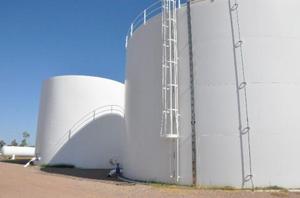
A letter would appear in the mail warning children less than six years of age and nursing or expectant mothers not to drink the water from the tap.
“We used to store bottles of water for people to get when these warnings went out, but now we just give them a voucher to a local water store,” said Ron Smith, operator for Thunderbird Farms Domestic Water Improvement District.
However, the district’s manager said he is working to put an end to these notices and to eliminate the voucher system by building a nearly $3 million water treatment facility that will meet the district’s shortcomings.
The district, located southwest of the city of Maricopa, covers more than 21,000 acres of land and includes a total of more than 600 parcels; 570 of them are active service connections.
The two primary water quality issues facing the district are arsenic and nitrates.
Nitrates are odorless, colorless and tasteless compounds whose presence in drinking water is mandated by the federal government not to exceed 10 parts per million.
While adults and children older than six months of age can break down ingested nitrates, infants tend to have difficulty digesting the chemical compound, which can lead to a bacterial infection.
From its creation in 1982 until 1990, the nitrate level in the district was constantly over 10 parts per million but since has dropped below that threshold.
“We have had times it has gotten above ten, but it hasn’t maintained that reading long enough to make us eligible for federal funds to address the issue,” Smith said.
Smith added that the primary source of nitrates in the district’s water supply originates from the septic tanks buried throughout the area.
In addition to the nitrate issue, in 2001 the EPA lowered the maximum parts per billion for arsenic in drinking water from 50 to 10.
“Since we became a district we have had 10 to 12 parts per billion of arsenic,” Smith said. “No one has ever been harmed drinking our water.”
Despite no one having been harmed by drinking the district’s water supply since its creation in the early 80s, Smith and others are taking steps to ensure the future safety of the water.
In the past 12 months two studies and designs have been completed to determine the treatment options available to correct the district’s water woes and, while the specific filtration methods have yet to be chosen, the new facility will call for the creation of a million-gallon storage tank and a 1,000 square-foot facility that will house treatment equipment, offices and more.
“We will pump water from our current two existing tanks, through the filtration station and into the new tank for distribution,” Smith said. “Any water quality issues we had a problem with in the past this new treatment facility will address.”
In addition to improving the quality of the water, this new plant will increase the plant’s capacity to one million gallons of water a day, much more than is needed to meet its current demand of 250,000 to 400,000 gallons a day.
While possible design options for the new plant are in place, Smith and others continue to seek funding for the project. “We are looking at both low interest rate loans and grants,” he said.
Through grants the company is eligible for up to 45 percent of the project’s total funding. However, when they increased the rate structure in November to be able to pay back loans, they did so counting on only 25 percent funding from grants.
“We wanted to budget for a worse case scenario so we didn’t have to come back and say we have to raise rates again,” Smith said. “We could actually come back and lower rates now, depending on the funding sources and loan structure.”
Photo by Michael K. Rich




![MHS G.O.A.T. a ‘rookie sleeper’ in NFL draft Arizona Wildcats wide receiver Jacob Cowing speaks to the press after a practice Aug. 11, 2023. [Bryan Mordt]](https://www.inmaricopa.com/wp-content/uploads/2024/04/cowing-overlay-3-218x150.png)



![Maricopa’s ‘TikTok Rizz Party,’ explained One of several flyers for a "TikTok rizz party" is taped to a door in the Maricopa Business Center along Honeycutt Road on April 23, 2024. [Monica D. Spencer]](https://www.inmaricopa.com/wp-content/uploads/2024/04/spencer-042324-tiktok-rizz-party-flyer-web-218x150.jpg)



![Alleged car thief released without charges Phoenix police stop a stolen vehicle on April 20, 2024. [Facebook]](https://www.inmaricopa.com/wp-content/uploads/2024/04/IMG_5040-218x150.jpg)




![MHS G.O.A.T. a ‘rookie sleeper’ in NFL draft Arizona Wildcats wide receiver Jacob Cowing speaks to the press after a practice Aug. 11, 2023. [Bryan Mordt]](https://www.inmaricopa.com/wp-content/uploads/2024/04/cowing-overlay-3-100x70.png)